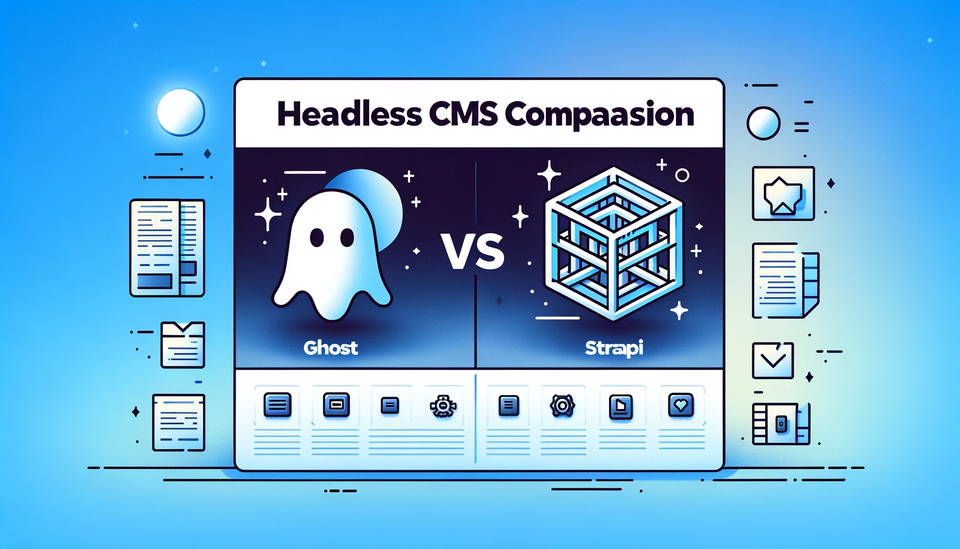Ghost vs Strapi - Open Source Headless CMS comparison

A comparison of popular open-source headless content management systems (CMS)
The rise of headless architectures has brought about a change in how we manage content. Now, the backend and frontend are separate, allowing for more flexibility in delivering content across different channels. In this comparison, we're putting Ghost and Strapi head-to-head, looking at them from an advanced development perspective to see which one is better suited for your digital toolkit.
What is headless CMS
A headless CMS separates content creation and management from the presentation layer, storing and delivering content through APIs rather than templates or an integrated frontend. This decoupled architecture provides flexibility to deliver content across multiple channels, devices and presentation layers using a centralized content repository. Headless CMSs focus on empowering content creators and editors with customizable administrative interfaces and workflows.
With a clear understanding of what a headless CMS entails, let's explore the features and offerings of Ghost and Strapi.
What is Ghost?
Ghost is an open-source headless content management system (CMS) that is purpose-built for online publications and blogs.
Some key features of Ghost include:
- An elegant and streamlined editing interface tailored for bloggers, content publishers, and journalists.
- While operating as a headless CMS that delivers content through APIs, Ghost primarily focuses on enhancing the end-user reading and browsing experience.
- Out-of-the-box, Ghost showcases content beautifully across various themes and incorporates modern features such as memberships and subscriptions.
- Powered by Node.js with a SQLite database on the backend, Ghost is remarkably easy to install and maintain, even for non-technical site owners.
- The Ghost community provides robust support, offering numerous custom integrations, apps, and themes.
- Ghost offers a 100% free self-hosted open-source version, and for those seeking managed cloud hosting, there's a paid option called Ghost(Pro).
What is Strapi?
Strapi is an open-source, flexible, and extensible headless CMS with a focus on content APIs rather than predefined themes or templates.
Some key features of Strapi include:
- Content creation and management delivered through APIs, eliminating the reliance on a predefined frontend or template.
- Built entirely with Javascript, Strapi is highly customizable and extensible to suit specific needs.
- Support for various data sources such as SQLite, Postgres, MySQL, and more.
- Creation of customizable APIs (REST, GraphQL, etc.) for delivering content to apps and websites.
- A robust plugin ecosystem that allows for easy extension of functionality.
- Strapi offers a 100% free self-hosted open-source community version, along with a paid self-hosted enterprise edition that includes additional features. Additionally, there are paid managed hosting options available.
Ghost vs Strapi: A side-by-side comparison
As previously mentioned, both Ghost and Strapi function as content management systems, each designed for specific purposes with unique features. The table below provides a detailed side-by-side technical comparison of Strapi and Ghost, tailored specifically for experienced developers.
| Feature | Ghost | Strapi |
|---|---|---|
| First Release | 2013 | 2015 |
| License | MIT | MIT + Enterprise |
| Built-in SEO Tools | Sitemap generation, Structured data, Meta tags | Via SEO Plugin |
| Accelerated Mobile Pages (AMP) | Yes | Not provided |
| Markdown Support | Yes | Limited |
| Membership/Subscriptions | Yes | No |
| Newsletter & Emails | Yes | Via Email Plugin |
| Custom HTML Support | Yes | Yes |
| Admin Panel | Yes, focussed towards blogging workflow | Basic, needs customization for specific use cases |
| Admin Panel Js Framework | Ember.js | ReactJs |
| Database Support | SQLite, MySQL | SQLite, MySQL, MariaDB, PostgreSQL |
| Self-hosted | Yes | Yes |
| REST API | Yes | Yes |
| GraphQL API | No | Yes |
| Internationalization Support (i18n) | Yes | Yes |
| User Management | Yes | Yes |
| Custom User Roles | No | Yes |
| SDKs Support | No | No |
Ghost vs Strapi: Pros and Cons
Now, let's examine the advantages and disadvantages of both Strapi and Ghost.
Ghost Pros:
- Focused on Blogging: Ghost is primarily designed for blogging and content publishing. If your main goal is to run a blog, Ghost provides a clean and user-friendly interface.
- Performance: Ghost is known for its performance optimization, providing a fast and efficient platform for content delivery.
- Markdown Support: Ghost uses Markdown for content creation, making it easy for users familiar with this lightweight markup language.
- Hosting Options: Ghost offers its own hosting service, simplifying deployment for users who don't want to deal with server management.
Ghost Cons:
- Limited Use Cases: While excellent for blogging, Ghost may not be the best choice for websites with diverse content types or complex structures.
- Extension Ecosystem: The available extensions and plugins for Ghost are not as extensive as some other CMS platforms.
Strapi Pros:
- Customization: Strapi is highly customizable, allowing developers to define their custom content types and fields. Developers can also customize the API structures as per their requirements.
- User roles and permissions: Strapi enables developers to establish and customize user roles and permissions, ensuring the security of content and restricting access to authorized users only.
- Wide Range of Use Cases: Strapi is suitable for various types of websites and applications, not limited to blogging. It can be used for e-commerce, portfolios, and more.
- Open Source: Strapi is an open-source platform, providing a large and active community that contributes to its development.
Strapi Cons:
- Learning Curve: Due to its flexibility and extensive features, Strapi may have a steeper learning curve for beginners.
- Performance: Depending on how it's implemented, Strapi might require additional optimization efforts to achieve high performance.
- Hosting: Unlike Ghost, Strapi hosting is directed towards well-established businesses and is not a great option for individuals.
Ghpst vs Strapi: Major Differences
Here are the key differences between Ghost vs Strapi when looking at them as headless CMS options:
- Focus: Ghost is primarily focused on blogging and publishing sites while Strapi is more general purpose for any use case needing custom content APIs.
- Technology: Both are headless CMSs built on Node.js. Ghost uses a simple SQLite database while Strapi supports multiple database options.
- Content Modeling: Strapi supports fully custom content types and customizable APIs while Ghost has a more fixed data model optimized for blogs/publications.
- User Interfaces: Ghost provides an elegant customizable admin UI for content creators focused on blogging while Strapi has a more generic admin UI but that is also highly customizable using modern frameworks.
- Extensibility: Strapi has a vibrant plugin ecosystem and is highly extensible through custom code. Ghost offers apps and themes but is more limited for custom functionality/integration compared to Strapi.
- Hosting: Ghost is primarily focused on self-hosted plus paid managed hosting while Strapi can be self-hosted but also more cloud provider agnostic to run on any platform.
Conclusion
In the realm of headless CMSs, finding the ideal solution depends on matching the tool to the specific requirements of your project. Ghost stands out as a nimble and focused choice, catering to straightforward publishing needs. On the other hand, Strapi empowers users with the freedom to meticulously shape their CMS environment, making it an excellent choice for those with the technical expertise to harness its full potential.
When making your decision, consider factors such as the scale of your project, the level of customizability required, the richness of the ecosystem, and, critically, how well the platform aligns with the unique demands of your content strategy.
In essence, there's no one-size-fits-all champion in the world of headless CMSs—just the right tool for the right job. The key is to carefully evaluate your specific needs and preferences to determine which platform aligns best with your goals and objectives.




Member discussion